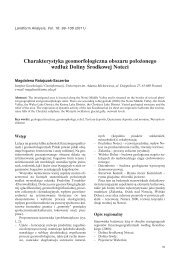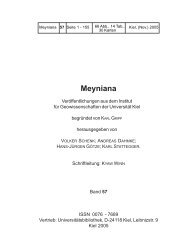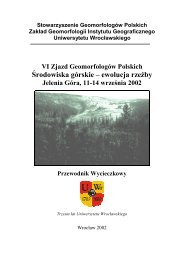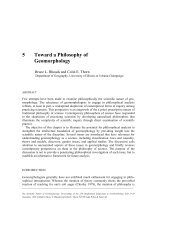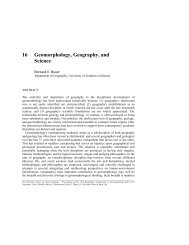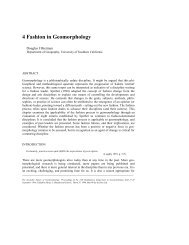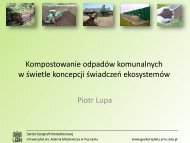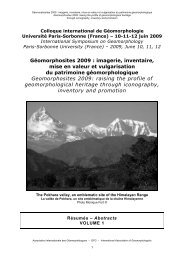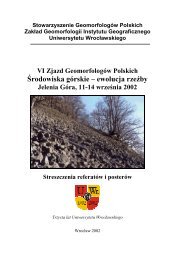Physical Modelling in Fluvial Geomorphology
Physical Modelling in Fluvial Geomorphology
Physical Modelling in Fluvial Geomorphology
Create successful ePaper yourself
Turn your PDF publications into a flip-book with our unique Google optimized e-Paper software.
222 SCIENTIFIC NATURE OF GEOMORPHOLOGY<br />
vegetation which will <strong>in</strong>crease the degree of model realism; (ii) cont<strong>in</strong>ued development<br />
and implementation of a range of measurement techniques; and (iii) detailed model:<br />
prototype verification across a range of scales. Whilst these steps will <strong>in</strong>crease<br />
significantly the power and attractiveness of scale modell<strong>in</strong>g <strong>in</strong> the earth sciences, simple<br />
analogue models will cont<strong>in</strong>ue to enable test<strong>in</strong>g of new concepts across the full range of<br />
spatial and temporal scales.<br />
INTRODUCTION<br />
Many problems <strong>in</strong> fluvial geomorphology <strong>in</strong>volve complex, multivariate situations, often<br />
at large spatial and temporal scales (see Kirkby, Chapter 10 this volume). These topics<br />
have traditionally been addressed through detailed fieldwork comb<strong>in</strong>ed with theoretical<br />
and numerical modell<strong>in</strong>g. Whilst mathematical models have promoted major advances <strong>in</strong><br />
our understand<strong>in</strong>g of the complex <strong>in</strong>terrelationships <strong>in</strong>volved <strong>in</strong> sediment production,<br />
transfer and deposition <strong>in</strong> dynamic fluvial environments (cf. Pickup 1988; Ikeda and<br />
Parker 1989; Kirkby 1994), they necessarily <strong>in</strong>volve simplifications and use of empirical<br />
coefficients derived from limited <strong>in</strong>put data. A complementary technique that has<br />
developed <strong>in</strong> parallel with these computational simulations is physical modell<strong>in</strong>g, which<br />
has two pr<strong>in</strong>cipal advantages. First, the formative processes can be observed, usually <strong>in</strong> a<br />
reduced time-frame, with<strong>in</strong> a controlled and manageable laboratory environment. Second,<br />
physical models may allow <strong>in</strong>corporation of variables which are not known a priori and<br />
which may have markedly non-l<strong>in</strong>ear effects on the resultant dynamics or morphology.<br />
However, these advantages are counterbalanced by prototype to model scal<strong>in</strong>g difficulties<br />
which result <strong>in</strong> <strong>in</strong>creas<strong>in</strong>g simplification and abstraction from reality as spatial and<br />
temporal scales <strong>in</strong>crease. Additionally, it is clearly important to establish and quantify the<br />
<strong>in</strong>fluences of processes which may be non-l<strong>in</strong>ear <strong>in</strong> their scal<strong>in</strong>g between model and<br />
prototype (e.g. particle settl<strong>in</strong>g velocity, see p. 233) and their consequent effect on<br />
morphology.<br />
<strong>Physical</strong> modell<strong>in</strong>g techniques can be classified both by their specificity (degree to<br />
which the model replicates a prototype) and the temporal/spatial scale at which they are<br />
most applicable (see Figure 9.1). For the smallest spatial and temporal scales, a 1:1 replica<br />
of flow and sediment dynamics can be re-created <strong>in</strong> the laboratory with little or no<br />
difference from the natural prototype. These models have, for example, been <strong>in</strong>strumental<br />
<strong>in</strong> <strong>in</strong>vestigat<strong>in</strong>g the morphology and controll<strong>in</strong>g variables of bedform generation both <strong>in</strong><br />
sands and gravels (e.g. Guy et al. 1966; Allen 1982; Southard and Boguchwal 1990a).<br />
However, even <strong>in</strong> these 1:1 models, care must be taken <strong>in</strong> consider<strong>in</strong>g temperature/<br />
viscosity <strong>in</strong>fluences (Southard and Boguchwal 1990b), apply<strong>in</strong>g such flume results to<br />
much deeper natural flows (Williams 1970; Southard 1971), and account<strong>in</strong>g for the<br />
<strong>in</strong>fluence of sidewalls on the experimental results (Crickmore 1970; Williams 1970). At<br />
large spatio-temporal scales, prototypes must be scaled down both to compress the time<br />
scale and allow the model to be accommodated with<strong>in</strong> the constra<strong>in</strong>ts of available<br />
laboratory space. For the largest prototypes, a true scaled modell<strong>in</strong>g approach becomes<br />
untenable and purely 'analogue' models must be employed. However, when viewed <strong>in</strong> the<br />
light of imposed modell<strong>in</strong>g constra<strong>in</strong>ts, these large-scale models (e.g. studies of base level<br />
controls on fluvial <strong>in</strong>cision) can provide <strong>in</strong>valuable <strong>in</strong>sights <strong>in</strong>to the behaviour of complex<br />
natural phenomena.



